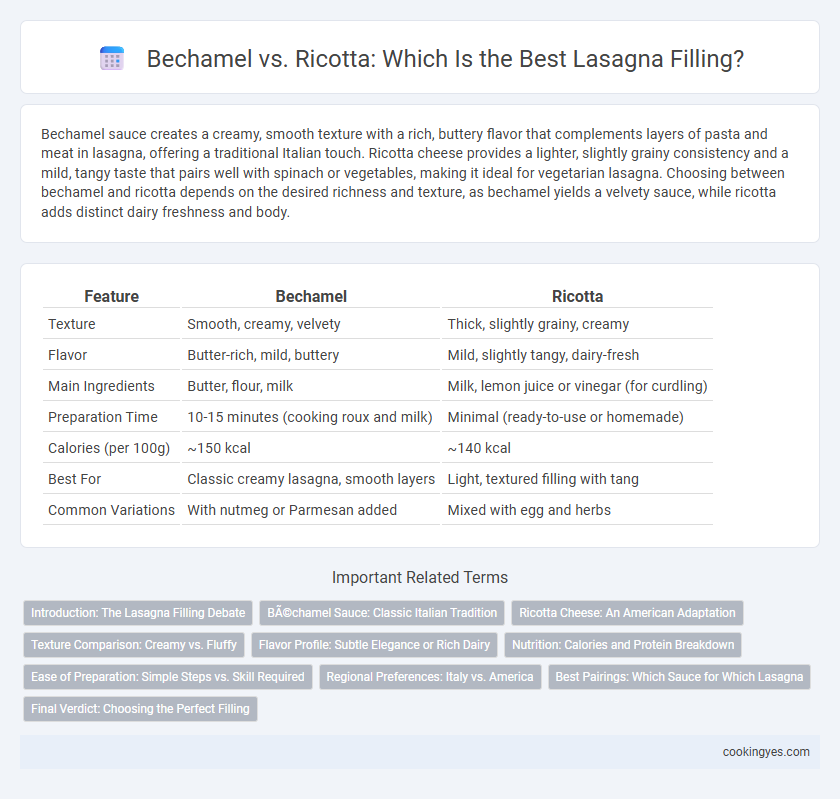Bechamel sauce creates a creamy, smooth texture with a rich, buttery flavor that complements layers of pasta and meat in lasagna, offering a traditional Italian touch. Ricotta cheese provides a lighter, slightly grainy consistency and a mild, tangy taste that pairs well with spinach or vegetables, making it ideal for vegetarian lasagna. Choosing between bechamel and ricotta depends on the desired richness and texture, as bechamel yields a velvety sauce, while ricotta adds distinct dairy freshness and body.
Table of Comparison
| Feature | Bechamel | Ricotta |
|---|---|---|
| Texture | Smooth, creamy, velvety | Thick, slightly grainy, creamy |
| Flavor | Butter-rich, mild, buttery | Mild, slightly tangy, dairy-fresh |
| Main Ingredients | Butter, flour, milk | Milk, lemon juice or vinegar (for curdling) |
| Preparation Time | 10-15 minutes (cooking roux and milk) | Minimal (ready-to-use or homemade) |
| Calories (per 100g) | ~150 kcal | ~140 kcal |
| Best For | Classic creamy lasagna, smooth layers | Light, textured filling with tang |
| Common Variations | With nutmeg or Parmesan added | Mixed with egg and herbs |
Introduction: The Lasagna Filling Debate
Bechamel and ricotta are two popular choices for lasagna filling, each offering distinct textures and flavors that impact the dish's overall appeal. Bechamel sauce provides a creamy, smooth consistency with a subtle buttery taste, enhancing the layers without overpowering other ingredients. Ricotta delivers a denser, slightly grainy texture with a mild, tangy flavor that contributes richness and heartiness to traditional Italian lasagna recipes.
Béchamel Sauce: Classic Italian Tradition
Bechamel sauce, a staple in classic Italian lasagna, offers a creamy, smooth texture that blends seamlessly with layers of pasta and rich meat sauce. Made from butter, flour, and milk, its velvety consistency enhances the dish's moisture and binds ingredients while providing a subtle, buttery flavor. This traditional choice contrasts with ricotta by delivering a lighter, silkier mouthfeel without the graininess often found in cheese-based fillings.
Ricotta Cheese: An American Adaptation
Ricotta cheese, a staple in American lasagna, offers a creamy, mild flavor that contrasts the richer, buttery bechamel traditionally used in Italian recipes. Its grainy texture and subtle sweetness provide a lighter alternative, enhancing the dish with a fresh, tangy profile. Ricotta's high moisture content also contributes to a moist, tender lasagna, distinguishing the American adaptation from the classic, bechamel-heavy version.
Texture Comparison: Creamy vs. Fluffy
Bechamel sauce provides a smooth, creamy texture that creates a rich and velvety lasagna filling, enhancing moisture and binding layers seamlessly. Ricotta offers a light, fluffy consistency with a slightly grainy bite, contributing a delicate structure that balances heavier components. Choosing bechamel results in a silkier mouthfeel, while ricotta adds airy softness, impacting the overall texture profile of the lasagna.
Flavor Profile: Subtle Elegance or Rich Dairy
Bechamel sauce offers a subtle elegance to lasagna with its creamy, velvety texture and delicate nutmeg undertones that enhance layers without overpowering. Ricotta cheese brings a rich dairy flavor characterized by its slightly grainy texture and mild tanginess, adding a hearty, rustic depth to each bite. Choosing between bechamel and ricotta influences the lasagna's overall taste profile, balancing smooth sophistication against robust creaminess.
Nutrition: Calories and Protein Breakdown
Bechamel sauce contains approximately 90 calories and 3 grams of protein per 1/4 cup serving, offering a creamy texture with moderate fat content. Ricotta cheese provides around 108 calories and 7 grams of protein per 1/4 cup, contributing higher protein and calcium while also increasing the richness of the lasagna filling. Choosing ricotta over bechamel can enhance the dish's nutritional profile by boosting protein intake and essential nutrients.
Ease of Preparation: Simple Steps vs. Skill Required
Bechamel sauce offers ease of preparation with simple steps involving butter, flour, and milk, requiring basic stovetop skills suitable for beginners. Ricotta filling demands more skill to achieve the right texture and seasoning, often involving mixing eggs, herbs, and cheese to ensure a creamy consistency. For quick assembly and minimal cooking expertise, Bechamel is preferable, while Ricotta suits cooks comfortable with balancing flavors and textures.
Regional Preferences: Italy vs. America
In Italy, traditional lasagna fillings favor bechamel sauce for its creamy, smooth texture that balances rich ragu, especially in regions like Emilia-Romagna where classic Lasagna alla Bolognese originates. American lasagna recipes often substitute bechamel with ricotta cheese, offering a denser, tangier layer that reflects broader preferences for heartier and cheesier lasagna variants. These regional differences highlight the Italian emphasis on delicate texture and sauce harmony versus the American preference for robust, cheese-forward lasagna fillings.
Best Pairings: Which Sauce for Which Lasagna
Bechamel sauce provides a creamy, smooth texture with a subtle nutmeg flavor that pairs best with traditional Italian lasagna recipes featuring rich meat sauces and melted mozzarella. Ricotta cheese offers a thicker, slightly grainy texture and a mild tang, making it ideal for vegetable or white lasagnas that highlight fresh herbs and lighter ingredients like spinach or mushrooms. Choosing bechamel enhances the classic, hearty meat lasagna experience, while ricotta complements vegetarian or delicate fillings for a balanced taste and texture.
Final Verdict: Choosing the Perfect Filling
Bechamel sauce provides a creamy, smooth texture with a rich, buttery flavor that enhances the traditional Italian lasagna experience. Ricotta cheese offers a lighter, slightly grainy consistency with a mild tang, contributing to a fresher, more rustic taste ideal for vegetable or white lasagnas. Choosing between bechamel and ricotta depends on the desired texture and flavor profile: bechamel delivers a velvety richness, while ricotta provides a lighter, protein-packed filling.
Béchamel vs Ricotta for Lasagna Filling Infographic

 cookingyes.com
cookingyes.com